
Higher_Mathematics_Part_3
.pdf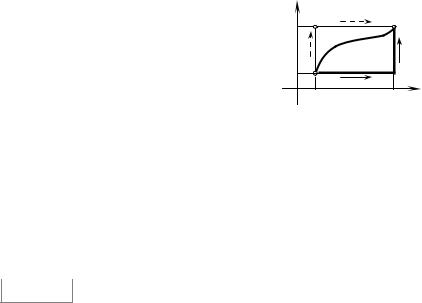
In this case evaluation of the integral can be done in different ways. For example, we can restore the function u(x, y), using the approach
of solution of the differential equation of the first order in total differentials. The simplest way is to integrate along a broken line (Fig. 7.7) whose parts are parallel to axes of coordinates.
Thus, we receive
у |
М |
В |
|
у1 |
|
||
|
L |
|
|
|
|
|
|
у |
А |
К |
|
0 |
|
|
|
О |
х0 |
х1 |
х |
Fig. 7.7
∫ P(x, y)dx + Q(x, y)dy = ∫ P(x, y)dx + Q(x, y)dy =
L AKB
= ∫ P(x, y)dx + Q(x, y)dy + ∫ P(x, y)dx + Q(x, y)dy =
|
AK |
KB |
|
x |
y |
|
= ∫1 P(x, y0 ) dx + ∫1 Q(x1 , y)dy. |
|
|
x0 |
y0 |
Theorem |
Let functions |
P(x, y, z) , Q(x, y, z) and R(x, y, z) be conti- |
|
|
|
nuous together with their partial derivatives of the first order in a simply connected domain D. Then the line integral
∫ P(x, y, z)dx + Q(x, y, z)dy + R(x, y, z)dz ,
L
is independent of the path of integration if and only if the next equalities hold
∂P |
= |
∂Q |
, |
∂Q |
= |
∂R |
, |
∂R |
= |
∂P . |
∂y |
|
∂x |
|
∂z |
|
∂y |
|
∂x |
|
∂z |
In this case the integrand expression is a total differential of the function u(x, y, z) , i.e.
P(x, y, z)dx + Q(x, y, z)dy + R(x, y, z)dz = du(x, y, z)
and
∫ P(x, y, z)dx + Q(x, y, z)dy + R(x, y, z)dz =
L
= u(xB , yB , zB ) − u(xA , yA , zA ),
where A(xA , yA , zA ) and B(xB , yB , zB ) are initial and terminal points of the path of integration L.
161
http://vk.com/studentu_tk, http://studentu.tk/
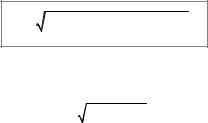
7.7.Application of Line Integral
1.Length L of a plane or space curve is evaluated by the formula
L = ∫ dl.
AB
In particular:
а) if a space curve is given by the equations x = x(t), y = y(t), z = z(t), t [α, β], then
β
L = ∫ (x′(t))2 + ( y′(t))2 + (z′(t))2 dt;
α
b) if a plane curve is given by the equation |
y = y(x) , |
x [а; b], then |
||||
|
|
|
|
|
|
|
|
b |
|
|
|
|
|
|
L = ∫ |
′ |
2 |
dx. |
|
(7.11) |
|
1+ ( y (x)) |
|
|
|||
|
a |
|
|
|
|
|
2. Area Р of a part of the cylindrical surface (Fig.7.2). The surface is formed by its directrix АВ lying in the plane Охy and its elements perpendicular to that plane, and bounded from above by the surface determined by the non-negative
function z = f (x, y) .P is defined by the formula:
|
|
|
|
|
P = ∫ |
f (x, |
|
y)dl. |
|
|
|
(7.12) |
|||
|
|
|
|
|
AB |
|
|
|
|
|
|
|
|
|
|
3. Mass m of a material curve L is evaluated by the formula |
|
||||||||||||||
|
|
|
|
|
|
|
|
|
|
|
|
||||
|
|
|
|
|
m = ∫ γ(x, y)dl, |
|
|
|
|
||||||
|
|
|
|
|
L |
|
|
|
|
|
|
|
|
|
|
where γ (x, y) is the line density of the curve L at the point M (x, |
y) . |
||||||||||||||
4. Coordinates xc , |
yc of the gravity center of the curve L may be found by |
||||||||||||||
formulas |
|
|
|
|
|
|
|
|
|
|
|
|
|
|
|
|
|
|
|
|
|
|
|
|
|
|
|||||
|
|
|
|
∫ xγ (x, y)dl |
|
|
∫ yγ (x, y)dl |
|
|
(7.13) |
|||||
|
x |
|
= L |
|
, y |
|
= L |
. |
|
||||||
|
c |
|
|
m |
|
|
c |
|
|
|
m |
|
|
|
|
|
|
|
|
|
|
|
|
|
|
|
|
|
|
||
|
|
|
|
|
|
|
|
|
|
|
|
|
|
|
|
5. Area S of the plane figure lying in the plane Оху and bounded by a closed contour L is evaluated by the formula
162
http://vk.com/studentu_tk, http://studentu.tk/
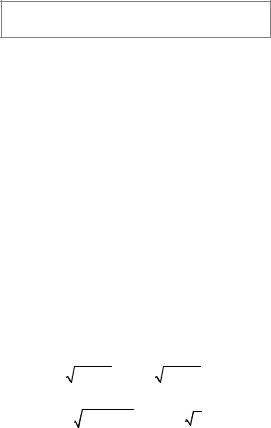
|
S = |
1 |
∫ xdy − ydx. |
|
(7.14) |
2 |
|||||
|
|
|
L |
|
|
6. Work done by a force |
|
|
|
||
F = P(x, y, z)i + Q(x, y, z) j + R(x, y, z)k |
|
||||
(functions P(x, y, z), Q(x, y, z), |
R(x, y, z) are continuous over the space |
||||
curve L) at moving a material point along the curve L is defined by the formula
A = ∫ P(x, y, z)dx + Q(x, y, z)dy + R(x, y, z)dz.
L
If a curve L lies in the plane Оху, the work done by the force |
F = P(x, y)i + |
|||||||||||
+Q(x, y) j at moving a material point along the curve is |
|
|
||||||||||
|
|
A = ∫ P(x, y)dx + Q(x, y)dy. |
|
(7.15) |
||||||||
|
|
|
L |
|
|
|
|
|
|
|||
|
|
|
Micromodule 7 |
|
|
|||||||
EXAMPLES OF PROBLEM SOLUTIONS |
|
|||||||||||
Example 1. Evaluate line integrals of the first type: |
|
|
||||||||||
а) ∫ xdl, where AB is the arc of the parabola y = x2 |
from the point A (0; 0) |
|||||||||||
AB |
|
|
|
|
|
|
|
|
|
|
|
|
up to the point B (1; 1) (Fig. 7.8); |
|
|
|
|
|
|
||||||
b) ∫ x2 ydl where L is an arc of the circumference |
x2 + y2 |
= 1 lying in the |
||||||||||
L |
|
|
|
|
|
|
|
|
|
|
|
|
first quarter (Fig. 7.9). |
|
|
|
|
|
|
|
|
|
|
|
|
Solution. а) We can find |
y′ = 2x and receive by the formula (7.2) |
|||||||||||
|
1 |
|
|
|
|
1 |
1 |
|
|
|
|
|
∫ xdl = ∫ x |
1+ 4x2 dx = |
∫ |
|
1+ 4x2 d(1+ 4x2 ) = |
|
|||||||
|
|
|||||||||||
AB |
0 |
|
8 |
0 |
|
|
|
|
|
|||
|
= |
1 |
(1+ 4x2 )3 |
|
1 |
= |
|
1 |
(5 5 −1). |
|
||
|
|
|
|
|||||||||
|
|
|
|
|
||||||||
|
|
|
|
|||||||||
|
12 |
|
|
0 |
|
12 |
|
|
|
|||
b) We can rewrite the equation of the circumference in the parametric form:
x = cos t, y = sin t, 0 ≤ t ≤ |
π |
. Then we have by the formula (7.4) |
|
2 |
|
163
http://vk.com/studentu_tk, http://studentu.tk/
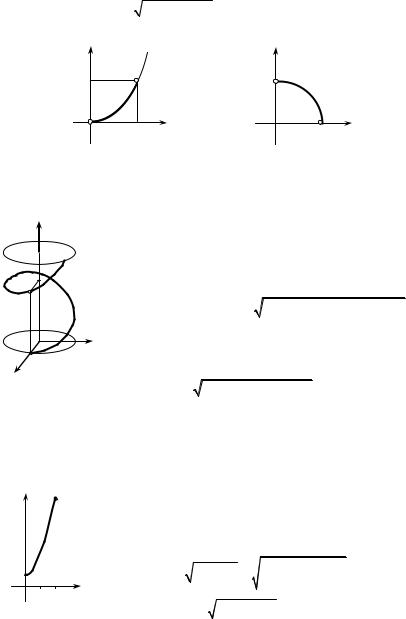
|
|
|
π |
|
|
|
|
π |
|
|
|
cos3 t |
|
π |
|
1 |
|
|||||
|
|
∫ x2 ydl = ∫2 cos2 t sin t |
sin2 t + cos2 tdt = −∫2 cos2 td(cost) = − |
|
2 |
= |
. |
|||||||||||||||
|
|
|
|
|
|
|||||||||||||||||
|
|
L |
0 |
|
|
|
|
|
0 |
|
|
|
|
3 |
|
0 |
3 |
|||||
|
|
|
|
|
|
|
|
|
|
|
|
|
|
|
|
|
|
|||||
|
|
|
|
у |
|
|
|
|
у |
|
|
|
|
|
|
|
|
|
|
|||
|
|
|
1 |
|
|
|
|
В |
1 |
|
В |
L |
|
|
|
|
|
|
|
|
||
|
|
|
|
|
|
|
|
|
|
|
|
|
|
|
|
|
||||||
|
|
|
|
А |
|
|
|
х |
О |
|
А |
|
х |
|
|
|
|
|
||||
|
|
|
|
|
|
|
|
|
|
|
|
|
|
|
||||||||
|
|
|
|
1 |
1 |
|
|
|
|
|
|
|||||||||||
|
|
|
|
|
|
|
|
|
|
|
|
|
|
|
|
|
|
|
||||
|
|
|
|
|
|
Fig. 7.8 |
|
|
|
Fig. 7.9 |
|
|
|
|
|
|
|
|
||||
|
|
Example 2. Determine the mass of a screw line described by the equations |
||||||||||||||||||||
x = 3cos t, |
y = 3sin t, |
z = 4t, 0 ≤ t ≤ 2π (Fig. 7.10) if the density |
|
γ |
at each |
|||||||||||||||||
|
|
z |
|
|
|
point |
(x, y, z) |
of the line is |
defined |
by the |
formula |
|||||||||||
|
|
|
|
|
|
γ (x, y, z) = 2z. |
|
|
|
|
|
|
|
|
|
|
|
|
|
|||
|
|
|
|
|
|
|
Solution. The mass of the given space curve may be |
|||||||||||||||
|
|
|
|
|
|
|
||||||||||||||||
|
|
8π |
|
|
|
defined by the formula |
|
|
|
|
|
|
|
|
|
|
||||||
|
|
|
|
|
|
|
|
|
|
|
|
|
|
|
|
|
|
|
|
|
|
|
|
|
|
|
|
|
|
|
|
b |
|
|
|
|
|
|
|
|
|
|
|
|
|
|
|
|
|
|
|
|
m = ∫ γ(x(t), y(t), z(t)) (x′(t))2 + ( y′(t))2 + (z′(t))2 dt. |
|||||||||||||||
|
|
|
|
|
|
|
|
|
a |
|
|
|
′ |
|
|
|
|
|
′ |
|||
|
|
О |
|
|
|
|
As γ(x, y, z) = 2z = 2 4t = 8t, |
|
|
|
|
|
||||||||||
|
|
|
|
|
|
x (t) = −3sin t, |
|
z (t) = 4 , |
||||||||||||||
|
|
|
|
3 у |
|
|
||||||||||||||||
|
|
3 |
|
y′(t) |
= 3 cos t, therefore |
|
|
|
|
|
|
|
|
|
|
|||||||
|
x |
|
|
|
|
|
|
|
|
|
|
|
|
|
||||||||
|
|
|
|
|
|
|
|
|
|
|
|
|
|
|
|
|
|
|
|
|
||
|
|
|
|
|
|
|
|
2π |
|
|
|
|
|
|
|
2π |
|
|
|
|
|
|
|
|
|
|
|
|
|
|
|
|
|
|
|
|
|
|
|
|
|
|
|
||
|
|
Fig. 7.10 |
|
|
|
m = ∫ 8t |
9sin2 t + 9cos2 t + 16dt = |
20t2 |
= 80π2 . |
|||||||||||||
|
|
|
|
|
0 |
|||||||||||||||||
|
|
|
|
|
|
|
|
|
0 |
|
|
|
|
|
|
|
|
|
|
|
|
|
Example 3. Find coordinates of the gravity center of a homogeneous arc of
the chain line
у
y = |
ex + e− x |
, 0 |
≤ x ≤ ln 2 (Fig. 7.11). |
|
2 |
||||
|
|
|
Solution. As the gravity center of a homogeneous arc does not depend on the value of density we shall consider it to be equal to 1. Then the mass of the arc will be numerically equal to the length of this arc. Taking into account that
|
|
|
|
|
′ 2 |
|
|
1 |
|
|
|
x |
|
− x |
|
2 |
|
1 |
2 |
|
1+ ( y ) |
= |
1+ |
4 |
|
(e |
|
− e |
|
) |
|
= |
|||
О |
х |
1 |
(ex |
+ e− x )2 = |
|
1 |
(ex + e− x ), |
||||||||||
|
|
|
= |
||||||||||||||
|
|
|
|||||||||||||||
|
Fig. 7.11 |
2 |
2 |
||||||||||||||
|
|
|
|
|
|
|
|
|
|
|
|
|
|
||||
164
http://vk.com/studentu_tk, http://studentu.tk/
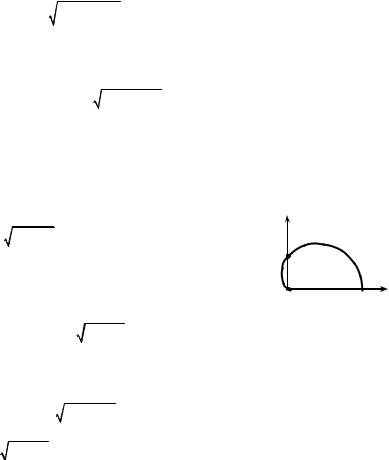
we receive by the formula (7.11)
|
|
|
|
|
|
|
|
|
|
|
|
|
|
|
|
|
1 |
|
ln 2 |
|
|
|
|
|
|
|
|
|
|
|
|
|
|
|
|
|
|
|
|
|
|
1 |
|
|
|
|
|
|
|
|
|
|
|
|
|
ln 2 |
|
|
|
3 |
|
|
|
|
|
||||||||||
|
|
|
|
|
|
|
|
|
|
|
|
|
|
|
|
|
|
|
|
|
|
|
|
|
|
|
|
|
|
|
|
|
|
|
|
|
|
|
|
|
|
|
|
|
|
|
|
|
|
|
|
|
|
|
|
|
|
|
|
||||||||||||||||
|
|
|
|
|
|
|
|
l = m = |
|
|
|
∫ (ex |
|
+ e− x )dx = |
|
(ex − e− x ) |
|
|
|
|
|
= |
|
|
. |
|
|
|
|
||||||||||||||||||||||||||||||||||||||||||||||
|
|
|
|
|
|
|
2 |
|
|
|
2 |
0 |
|
|
|
4 |
|
|
|
|
|||||||||||||||||||||||||||||||||||||||||||||||||||||||
|
|
|
|
|
|
|
|
|
|
|
|
|
|
|
|
|
|
|
|
0 |
|
|
|
|
|
|
|
|
|
|
|
|
|
|
|
|
|
|
|
|
|
|
|
|
|
|
|
|
|
|
|
|
|
|
|
|
|
|
|
|
|
|
|
|
|||||||||||
|
|
|
|
|
|
|
|
|
|
|
|
|
|
|
|
|
|
|
|
|
|
|
|
|
|
|
|
|
|
|
|
|
|
|
|
|
|
|
|
|
|
|
|
|
|
|
|
|
|
|
|
|
|
|
|
|
|
|
|
|
|
|
|
|
|
|
|
|
|
|
|
||||
After using the formula (7.13) we find |
|
|
|
|
|
|
|
|
|
|
|
|
|
|
|
|
|
|
|
|
|
|
|
|
|
|
|
|
|
|
|
|
|
|
|||||||||||||||||||||||||||||||||||||||||
|
|
|
4 |
ln 2 |
|
|
|
|
|
|
|
( y′ (x))2 dx = |
2 |
ln 2 |
(x (ex + e− x ))dx = |
|
2 |
x |
(ex − e− x ) |
|
ln02 − |
||||||||||||||||||||||||||||||||||||||||||||||||||||||
|
|
|
|
|
|
|
|
|
|
|
|||||||||||||||||||||||||||||||||||||||||||||||||||||||||||||||||
xc = |
|
∫ x 1+ |
|
|
∫ |
|
|
||||||||||||||||||||||||||||||||||||||||||||||||||||||||||||||||||||
|
3 |
|
3 |
|
|
3 |
|||||||||||||||||||||||||||||||||||||||||||||||||||||||||||||||||||||
|
|
|
0 |
|
|
|
|
|
|
|
|
|
|
|
|
|
|
|
|
|
|
|
|
|
|
|
|
|
0 |
|
|
|
|
|
|
|
|
|
|
|
|
|
|
|
|
|
|
|
|
|
|
|
|
|
|
|
|
|
|
|
|
|
|
|
|
|
|
||||||||
|
|
|
|
|
|
|
|
|
|
|
|
|
|
|
|
|
|
|
|
|
|
|
|
|
|
|
|
|
|
|
|
|
|
|
|
|
|
|
|
|
|
|
|
|
|
|
|
|
|
|
|
|
|
|
|
|
|
|
|
|
|
|
|
|
|||||||||||
|
ln 2 |
|
(ex − e− x )dx = |
|
2 x (ex |
− e− x ) |
|
ln 2 |
− (ex |
+ e− x ) |
|
ln 2 |
= 1 (3ln 2 − 1); |
||||||||||||||||||||||||||||||||||||||||||||||||||||||||||||||
|
|
|
|
|
|||||||||||||||||||||||||||||||||||||||||||||||||||||||||||||||||||||||
− ∫ |
|
|
|
|
|
||||||||||||||||||||||||||||||||||||||||||||||||||||||||||||||||||||||
|
|
|
|
|
|
|
|
|
|
|
|
|
|
|
|
|
|
|
|
|
|
|
|
|
|
|
|
|
|
|
|
|
|
|
|
|
|
|
|
|
|
|
|
|
|
|
|
|
|
|
|
|
|
|
|
|
|
|
|
|
|
|
|
|
|
||||||||||
|
0 |
|
|
|
|
|
|
|
|
|
|
|
|
|
|
|
|
|
3 |
|
|
|
|
|
|
|
|
|
|
|
|
|
|
|
|
|
|
|
0 |
|
|
|
|
|
|
|
|
|
|
|
|
|
|
|
|
0 |
|
|
|
|
3 |
|
|
|
|
|
|
|
|||||||
|
|
|
|
|
|
|
|
|
|
4 ln 2 |
|
|
|
|
|
|
|
|
|
′ |
|
|
|
|
2 |
|
|
|
|
|
|
|
|
|
4 ln 2 ex + e− x |
|
ex |
|
+ e− x |
|
|
|
|
|
|
|
|||||||||||||||||||||||||||||
|
|
|
|
|
yc = |
|
|
|
∫ |
y 1+ ( y (x)) |
|
dx |
= |
|
|
|
|
|
|
|
∫ |
|
|
|
|
|
|
|
|
|
|
|
|
|
|
|
|
|
|
|
|
|
|
dx = |
|
|
|
||||||||||||||||||||||||||||
|
|
|
|
|
3 |
|
|
|
3 |
|
|
|
|
|
2 |
|
|
|
|
|
|
|
|
|
|
2 |
|
|
|
|
|
|
|
|
|||||||||||||||||||||||||||||||||||||||||
|
|
|
|
|
|
|
|
|
|
|
|
|
0 |
|
|
|
|
|
|
|
|
|
|
|
|
|
|
|
|
|
|
|
|
|
|
|
|
|
|
|
|
|
|
0 |
|
|
|
|
|
|
|
|
|
|
|
|
|
|
|
|
|
|
|
|
|
|
|
|
|
|
|
|
|
||
|
|
|
|
|
|
|
|
1 ln 2 |
|
|
|
2x |
|
|
|
|
|
|
|
|
|
−2 x |
|
|
|
|
|
|
1 1 |
|
2 x |
|
|
|
|
|
|
1 |
|
|
|
−2x |
|
|
|
ln 2 |
|
|
|
|
|||||||||||||||||||||||||
|
|
|
|
|
|
|
|
|
|
|
|
|
|
|
|
|
|
|
|
|
|
|
|
|
|
|
|
|
|
|
|
|
|
|
|
|
|
|
|
|
|
|
|||||||||||||||||||||||||||||||||
|
|
|
|
|
= |
|
|
∫ (e |
|
+ |
2 + e |
|
|
|
|
)dx = |
|
|
( |
|
e |
|
|
+ 2x − |
|
e |
|
|
|
) |
|
|
|
|
|
|
= |
|
|
|
|||||||||||||||||||||||||||||||||||
|
|
|
|
|
|
3 |
|
|
|
|
|
3 |
2 |
|
|
2 |
|
|
|
|
0 |
|
|
|
|
|
|
||||||||||||||||||||||||||||||||||||||||||||||||
|
|
|
|
|
|
|
0 |
|
|
|
|
|
|
|
|
|
|
|
|
|
|
|
|
|
|
|
|
|
|
|
|
|
|
|
|
|
|
|
|
|
|
|
|
|
|
|
|
|
|
|
|
|
|
|
|
|
|
|
|
|
|
|
|
|
|
|
|
|
|
|
|||||
|
|
|
|
|
|
|
= |
1 |
|
1 |
|
|
4 + 2 ln 2 |
− |
1 |
|
1 |
|
= |
1 |
|
|
(16ln 2 + |
15). |
|
|
|
|
|
|
|
|
|||||||||||||||||||||||||||||||||||||||||||
|
|
|
|
|
|
|
|
|
|
|
|
|
|
|
|
|
|
|
|
|
|
|
|
|
|
|
|
|
|
|
|
||||||||||||||||||||||||||||||||||||||||||||
|
|
|
|
|
|
|
3 |
2 |
|
2 |
4 |
24 |
|
|
|
|
|
|
|
|
|
||||||||||||||||||||||||||||||||||||||||||||||||||||||
|
|
|
|
|
|
|
|
|
|
|
|
|
|
|
|
|
|
|
|
|
|
|
|
|
|
|
|
|
|
|
|
|
|
|
|
|
|
|
|
|
|
|
|
|
|
|
|
|
|
|
|
|
|
|
|
|
|
|
|
|
|||||||||||||||
Example 4. Evaluate the line integral of the first |
|
|
|
|
у |
|
|
|
|
|
|
|
|
|
|
|
|||||||||||||||||||||||||||||||||||||||||||||||||||||||||||
type ∫ |
x2 + y2 dl |
|
where |
|
|
L is |
|
the |
|
upper |
|
half |
of |
|
the |
|
|
|
|
1 |
|
|
|
|
|
|
|
|
|
|
|
||||||||||||||||||||||||||||||||||||||||||||
L |
|
|
|
|
|
|
|
|
|
|
|
|
|
|
|
|
|
|
|
|
|
|
|
|
|
|
|
|
|
|
|
|
|
|
|
|
|
|
|
|
|
|
|
|
|
|
|
|
|
|
|
|
|
|
|
|
|
|
|
|
|
|
|
|
|
|
|
|
|
|
|
|
|
|
|
cardioid ρ = 1+ cos ϕ (Fig. 7.12). |
|
|
|
|
|
|
|
|
|
|
|
|
|
|
|
|
|
|
|
|
|
|
|
|
|
|
|
|
|
|
|
|
|
|
|
|
|
|
|
|
|
|
|
|
|
|
|||||||||||||||||||||||||||||
Solution. We pass to polar coordinates |
by |
|
the |
|
|
|
|
О |
|
|
|
|
|
|
|
|
|
2 х |
|||||||||||||||||||||||||||||||||||||||||||||||||||||||||
formulas |
x = ρ cos ϕ , |
y = ρ sin ϕ , then |
|
|
|
|
|
|
|
|
|
|
|
|
|
|
|
|
|
|
|
|
|
|
|
|
|
|
|
|
|
|
|
|
|
|
|
|
|
|
|
|
|||||||||||||||||||||||||||||||||
|
|
|
|
|
|
|
|
|
|
|
|
|
|
|
|
x2 + y2 |
|
= |
|
ρ . |
|
|
|
|
|
|
|
|
|
|
|
|
|
|
|
|
|
|
|
|
|
|
|
|
|
|
|
|
|
|
|
|
|
|
|
|
|
|
|
|
|
Fig. 7.12 |
|||||||||||||
|
|
|
|
|
|
|
|
|
|
|
|
|
|
|
|
|
|
|
|
|
|
|
|
|
|
|
|
|
|
|
|
|
|
|
|
|
|
|
|
|
|
|
|
|
|
|
|
|
|
|
|
|
|
|
|
|
|
|
|
|
|
|
|||||||||||||
So as ρ′ = − sin ϕ , |
|
|
|
|
|
|
|
|
|
|
|
|
|
|
|
|
|
|
|
|
|
|
|
|
|
|
|
|
|
|
|
|
|
|
|
|
|
|
|
|
|
|
|
|
|
|
|
|
|
|
|
|
|
|
|
|
|
|
|
||||||||||||||||
|
|
|
|
|
ρ2 + (ρ′)2 |
= (1+ cos |
ϕ)2 + sin2 ϕ = 2 |
+ 2 cos ϕ = 4 cos2 ϕ |
, |
|
|
||||||||||||||||||||||||||||||||||||||||||||||||||||||||||||||||
|
|
|
|
|
|
|
|
|
|
|
|
|
|
|
|
|
|
|
|
|
|
|
|
|
|
|
|
|
|
|
|
ϕ |
|
|
|
|
|
|
|
|
|
|
|
|
|
ϕ |
|
|
|
|
|
|
|
|
|
|
|
|
|
|
|
|
|
|
|
|
|
2 |
|
|
|
||||
|
|
|
|
|
|
|
|
|
|
|
|
2 |
|
|
|
′ |
|
2 |
|
|
|
|
|
|
|
|
|
|
|
|
|
|
|
|
|
|
|
|
|
|
|
|
|
ϕ [0; π] , |
|
|
|
|
|||||||||||||||||||||||||||
|
|
|
|
|
|
|
|
|
|
ρ |
|
|
|
+ (ρ ) |
|
|
= 2 |
cos |
2 |
|
= 2cos 2 |
|
|
for |
|
|
|
|
|||||||||||||||||||||||||||||||||||||||||||||||
|
|
|
|
|
|
|
|
|
|
|
|
|
π |
|
|
|
|
|
|
|
|
|
ϕ |
|
|
|
|
|
|
π |
|
|
|
|
|
|
|
|
|
|
|
|
|
|
|
|
|
|
|
|
|
ϕ |
|
|
|
|
|
|
|
|
|
|
|
|
|
|
|
|
|||||||
then ∫ |
|
2 |
|
|
2 |
|
|
|
|
|
∫ρ 2cos |
|
|
|
|
|
|
|
|
|
|
|
|
|
|
|
|
|
|
|
|
|
|
|
|
|
|
|
|
|
|
|
|
|
|
|
|
|
|
|
|
|
|
|
|
|
|||||||||||||||||||
x |
|
|
+ y |
|
dl = |
2dϕ = ∫(1+ cos ϕ) 2cos |
2dϕ = |
|
|
|
|
|
|
|
|
|
|
||||||||||||||||||||||||||||||||||||||||||||||||||||||||||
L |
|
|
|
|
|
|
|
|
|
|
|
|
0 |
|
|
|
|
|
|
|
|
|
|
|
|
|
|
|
|
|
0 |
|
|
|
|
|
|
|
|
|
|
|
|
|
|
|
|
|
|
|
|
|
|
|
|
|
|
|
|
|
|
|
|
|
|
|
|
|
|
|
|
|
|
||
|
|
|
|
|
|
|
π |
|
|
|
|
2 |
ϕ |
4 cos |
|
ϕ |
d |
ϕ |
|
|
|
|
|
|
|
|
|
π |
|
|
|
|
|
2 |
|
ϕ |
|
|
|
|
|
|
|
ϕ |
= |
|
|
|
|||||||||||||||||||||||||||
|
|
|
|
|
= ∫ 2 cos |
|
|
|
|
|
|
|
|
|
|
= 8∫ |
1− sin |
|
|
|
|
|
|
|
d sin |
|
|
|
|
|
|
||||||||||||||||||||||||||||||||||||||||||||
|
|
|
|
|
|
|
0 |
|
|
|
|
|
|
|
|
2 |
|
|
|
|
|
|
|
|
|
2 |
|
|
2 |
|
|
|
|
|
|
|
|
0 |
|
|
|
|
|
|
|
2 |
|
|
|
|
|
|
|
|
|
2 |
|
|
|
|
|||||||||||||||
|
|
|
|
|
|
|
|
|
|
|
|
|
|
|
|
|
|
|
|
|
ϕ |
|
|
1 |
|
|
|
|
3 ϕ |
π |
|
|
|
|
|
|
1 |
|
|
|
|
|
|
|
16 |
|
|
|
|
|
|
|
|
|
|
|
|||||||||||||||||||
|
|
|
|
|
|
|
|
|
|
|
|
= 8 sin |
|
|
|
− |
|
|
|
sin |
|
|
|
|
|
|
|
|
|
= 8 |
1− |
|
|
|
|
= |
|
|
|
. |
|
|
|
|
|
|
|
|
|
|
|||||||||||||||||||||||||
|
|
|
|
|
|
|
|
|
|
|
|
2 |
3 |
|
|
2 |
|
|
|
3 |
|
3 |
|
|
|
|
|
|
|
|
|
|
|||||||||||||||||||||||||||||||||||||||||||
|
|
|
|
|
|
|
|
|
|
|
|
|
|
|
|
|
|
|
|
|
|
|
|
|
|
|
|
0 |
|
|
|
|
|
|
|
|
|
|
|
|
|
|
|
|
|
|
|
|
|
|
|
|
|||||||||||||||||||||||
165
http://vk.com/studentu_tk, http://studentu.tk/
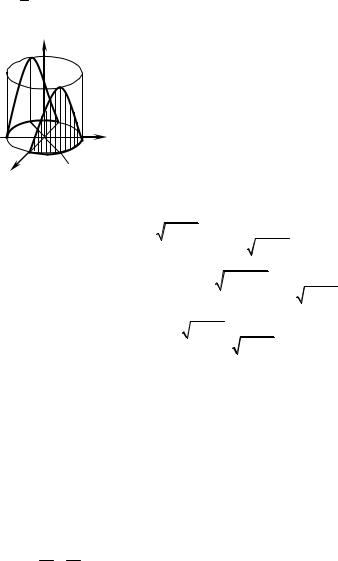
Example 5. Evaluate the area of the lateral surface of the circular cylinder x2 + y2 = 4 bounded by the plane Оху and by the hyperbolic paraboloid
z = 14 xy (Fig. 7.13).
z
|
О |
2 y |
x |
2 |
у = х |
|
||
|
Fig. 7.13 |
|
Solution. Proceeding from the geometrical meaning of a line integral of the first type, the problem is reduced to evaluation of the line integral of the function
f (x, y) = |
1 |
|
xy |
( f (x, y) ≥ 0) over the |
circumference |
|||
|
||||||||
x2 + y2 |
4 |
|
|
|
f (x; y) ≥ 0 for |
|||
= 4 |
(the formula (7.12)). As |
|||||||
x ≥ 0 , |
y ≥ 0 |
and x ≤ 0, y ≤ 0 , and the surface z = |
xy |
|
||||
|
||||||||
is symmetric relative to the plane y = x |
4 |
|
||||||
it is possible to |
||||||||
reduce the evaluation of the integral only along the fourth part of the circumference which lies in the first quarter of the plane. We receive
y = 4 − x2 , y′ = − |
x |
, |
|
4 − x2
1+ ( y′)2 = |
|
4 |
, dl = 1 |
+ ( y′)2 dx = |
2dx |
, |
||||
|
− x2 |
4 − x2 |
||||||||
4 |
|
|
|
|
||||||
|
|
2 |
|
2 |
|
|
|
2 |
|
|
P = ∫ f (x, y)dl = 2∫ x 4 − x2 |
dx = 2 x2 |
|
= 8. |
|||||||
|
||||||||||
L |
0 |
|
4 − x2 |
|
|
0 |
|
|||
|
|
|
||||||||
Example 6. Evaluate line integrals of the second type:
а) ∫ x2 dx + xydy if АВ is a line segment connecting the points А(1; 1) and
AB
В(2; 3) (Fig. 7.14);
b) ∫ (x − y)dx + (x + y)dy if L is the broken line ОАВ, where O(0;0), A(2;0),
L
В(2;3) (Fig. 7.15);
c) ∫ xdx + y2 dy if AB is the arc of the parabola y = x2 from the point A(0;
AB
0) to the point B (2; 4) (Fig. 7.16);
d) ∫ dx − dy if L is the first quarter of the circumference x2 + y2 = 4 (direc-
L y x
tion of motion is clockwise).
166
http://vk.com/studentu_tk, http://studentu.tk/
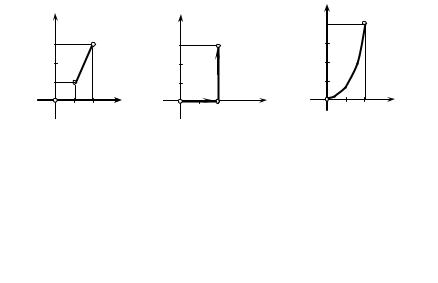
у |
|
у |
|
|
у |
В |
|
|
|
|
|
4 |
|
||||
|
|
|
|
|
|
|||
|
В |
|
|
|
|
|
||
3 |
3 |
В |
|
|
|
|
||
1 |
А |
|
А |
|
|
|
|
|
О |
1 2 х |
О |
х |
А |
2 |
х |
||
2 |
||||||||
Fig. 7.14 |
|
Fig. 7.15 |
|
|
Fig. 7.16 |
|
||
Solution: а) We can write down an equation of the straight line passing
through two points A (1; 1) and B (2; 3): |
x − 1 |
= |
y − 1 |
, i.e. |
y = 2x − 1. The |
|||
2 − 1 |
|
3 − 1 |
|
|||||
|
|
|
|
|||||
equation of the segment АВ is: y = 2x − 1, 1 ≤ x ≤ 2 . And by the formula (7.7) we receive:
|
2 |
2 |
26 |
|
|
∫ x2 dx + xydy = ∫(x2 + x(2x − 1) 2)dx = ∫(5x2 − 2x)dx = |
. |
||||
3 |
|||||
AB |
1 |
1 |
|
||
b) We can rewrite the integral as a sum of two integrals, first of which we take over the line segment ОА, and the second one over the line segment АВ. For
the segment ОА y = 0, dy = 0, 0 ≤ x ≤ 2, therefore
|
|
|
2 |
|
|
|
|
|
|
|
|
|
|
|
∫ (x − y)dx + (x + y)dy = ∫ xdx = 2. |
|
|
|
|
|
|||||||
|
OA |
|
0 |
|
|
|
|
|
|
|
|
|
|
For the segment AB x = 2 , dx = 0 , 0 ≤ y ≤ 3 , therefore |
|
|
|
|
|
||||||||
|
|
3 |
|
y2 |
|
3 |
|
9 |
|
|
|||
|
|
|
|
|
|
||||||||
∫ (x − y)dx + (x + y)dy = ∫(2 + y)dy = 2 y + |
|
|
|
= 6 + |
|
|
= 10,5. |
||||||
|
|
|
|||||||||||
AB |
|
0 |
|
2 |
|
0 |
|
2 |
|
|
|||
So, |
∫ (x − y)dx + (x + y)dy = 2 + 10, 5 = 12, 5. |
|
|
|
|
|
|||||||
|
L |
|
|
|
|
|
|
|
|
|
|
|
|
c) We have (see Fig. 7.16): |
|
|
|
|
|
|
|
|
|
|
|
||
|
|
|
2 |
4 |
|
|
70 |
|
|||||
∫ xdx + y2 dy = ∫ xdx + ∫ |
y2 dy = ∫ xdx + ∫ y2dy = |
. |
|||||||||||
|
|||||||||||||
AB |
AB |
AB |
0 |
0 |
|
|
|
3 |
|
|
|||
d) We can rewrite the equation of the given circumference arc in the para-
metrical form: x = 2 cos t, y = 2sin t, 0 ≤ t ≤ |
π |
. Then x′(t) = −2sint, y′(t) = 2cost. |
Using the formula (7.6) we receive: |
2 |
|
|
|
|
|
|
167 |
http://vk.com/studentu_tk, http://studentu.tk/
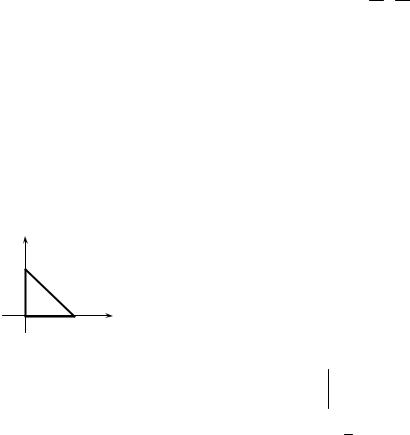
|
dx |
|
dy |
0 |
|
2sin t |
|
2 cos t |
0 |
π |
|
|
|
|
|
2 |
|||||||
∫ |
|
− |
|
= ∫ |
− |
|
− |
|
dt = −2∫ dt = 2∫ dt = π. |
||
y |
x |
2sin t |
|
||||||||
AB |
|
π |
|
|
2 cos t |
π |
0 |
||||
|
|
|
|
2 |
|
|
|
|
|
2 |
|
Example 7. Evaluate the area of the domain bounded by the ellipse x2 + y2 = 1. a2 b2
Solution. We can rewrite the equation of the ellipse in parametrical form:
x = a cos t, y = b sin t, |
t [0; 2π] . For |
evaluation of the area |
we apply the |
||||||||
formula (7.14). Then |
|
|
|
|
|
|
|
||||
|
1 |
|
|
|
1 |
2π |
|
|
|
|
|
S = |
∫ xdy − ydx = |
∫ (a cos t bsin t + bsin t a sin t )dt = |
|||||||||
2 |
2 |
||||||||||
|
|
L |
0 |
|
|
|
|
||||
|
|
|
ab |
2π |
|
ab |
2π |
|
|||
|
|
= |
∫ (cos2 t + sin2 t)dt = |
∫ dt = πab. |
|
||||||
|
|
2 |
2 |
|
|||||||
|
|
|
|
0 |
|
|
0 |
|
|||
Example 8. Evaluate the line integral |
I = ∫ (x2 + y2 )dx + xdy |
using Green’s |
|||||||||
L
formula if L is a set of sides of the triangle whose vertices are the points A (0; 0), B(1; 0), C(0; 1) (Fig. 7.17).
у |
|
|
|
|
|
Solution. We have P = x2 + y2 , Q = x, |
∂Q |
− |
∂P |
= |
||
|
|
|
|
|
|
|||||||
1 |
|
В |
|
= 1− 2y . By the formula (7.9) we receive |
∂x |
|
∂y |
|
||||
|
|
|
|
|
|
|||||||
|
|
х + у = 1 |
|
|
|
|
|
|||||
|
|
|
∫ (x2 + y2 )dx + xdy = ∫∫(1− 2 y)dxdy |
|
|
|
||||||
|
|
|
|
А |
х |
|
|
|
||||
О |
1 |
L |
D |
|
|
|
|
|||||
where the domain D is the triangle ОАВ. As an equation |
||||||||||||
|
|
Fig. 7.17 |
|
|||||||||
|
|
|
of the side AB looks like х + y = 1, then |
|
|
|
|
|||||
1 1− x |
1 |
I = ∫∫ (1− 2 y)dxdy = ∫ dx ∫ |
(1− 2 y)dy = ∫ ( y − y2 ) |
D |
0 0 |
|
|
|
1 |
|
|
|
∫ |
(1− x − (1− x)2 )dx = |
|
= |
|
|
|
|
0 |
|
|
|
|
(1;2) |
|
Example 9. Evaluate I = ∫ (x2 +
|
|
|
0 |
|
|
|
|
(1− x)2 |
|
(1− x)3 |
|
|
1 |
|
|
|
||||
− |
|
+ |
|
|
|
|
|
|
|||||
|
2 |
|
3 |
|
|
0 |
|
|
|
|
y)dx + (x + 2 y)dy.
(0;0)
1− x
dx =
0
= 16 .
Solution. We should check up the condition of the line integral to be path-
independent: P = x2 + y , Q = x + 2y , |
∂P |
= |
∂Q |
= 1 . |
|
∂y |
|
∂x |
|
168 |
|
|
|
|
http://vk.com/studentu_tk, http://studentu.tk/

As the condition (7.10) is fulfilled, the integral is pathindependent. We can move from the point (0; 0) to the point (1; 2) along the broken line ОАВ (Fig. 7.18). We have for ОА: y = 0, dy = 0, 0 ≤ x ≤ 1; on АВ: х = 1, dx = 0, 0 ≤ y ≤ 2 .
So,
1 |
|
2 |
|
x |
3 |
|
|
1 |
|
|
2 |
|
19 |
|
1 |
|
|
|
|
|
|
|
|
|
|
||||||||||
I = ∫ x |
2 |
dx + ∫ (1 |
+ 2 y)dy = |
|
|
|
+ ( y + y |
2 |
) |
= |
= 6 |
. |
|||||
|
3 |
|
|
|
0 |
|
3 |
3 |
|||||||||
0 |
|
0 |
|
|
|
0 |
|
|
|
|
|
|
|||||
|
|
|
|
|
|
|
|
|
|
|
|
|
|
||||
у
2  В
В
|
|
А |
О |
1 |
х |
Fig. 7.18
Example 10. Evaluate the work done by the force F = y2 i + x j at moving a material point along the line segment connecting the points A (1; 2) and B (2; 4).
Solution. It is necessary to evaluate the line integral of the second type of functions P = y2 and Q = x along the line segment АВ. We can write down an
equation of the segment АВ: |
|
x − 1 |
= |
|
y − 2 |
, |
from here |
y = 2x . By the formula |
|||||||||||||||||
|
|
|
|
|
|
||||||||||||||||||||
(7.14) we have |
|
|
|
|
|
|
|
2 − 1 |
|
|
4 − 2 |
|
|
|
|
|
|
|
|
||||||
|
|
|
|
|
|
|
|
|
|
|
|
|
|
|
|
|
|
|
2 |
|
|
4 |
|
|
|
|
|
|
|
|
|
|
|
|
|
|
|
|
|
|
|
|
|
|
|
|
|
y |
|
||
A = ∫ y2 dx + xdy = ∫ |
|
y2 dx + ∫ |
xdy = ∫ 4x2 dx + ∫ |
dy = |
|||||||||||||||||||||
|
2 |
||||||||||||||||||||||||
AB |
|
|
|
|
|
|
|
|
AB |
|
|
|
|
AB |
|
|
1 |
|
|
2 |
|
||||
|
|
|
|
|
|
|
|
|
|
|
|
|
|
|
|
|
|
||||||||
|
4 |
x |
3 |
|
2 |
|
y2 |
|
4 |
|
|
4 |
|
|
|
1 |
|
|
37 |
|
|
|
|||
|
|
|
|
|
|
|
|
|
|
|
|
|
|
||||||||||||
= |
|
|
|
+ |
|
|
|
|
|
|
= |
|
|
(8 −1) |
+ |
|
(16 − 4) |
= |
|
. |
|
|
|||
3 |
|
|
4 |
|
|
|
3 |
4 |
3 |
|
|
||||||||||||||
|
|
|
|
1 |
|
|
|
2 |
|
|
|
|
|
|
|
|
|
|
|||||||
Example 11. Evaluate the line integral |
∫ ( |
) |
|
|
( |
x2 |
− cos y |
) |
dy |
if L |
||||||||||||||
|
|
x3 + 2xy dx + |
|
|
||||||||||||||||||||
is the ellipse x2 + 4 y2 |
|
|
|
|
|
|
|
|
|
|
L |
|
|
|
|
|
|
|
|
|
|
|
||
= 4 . |
|
|
|
|
|
|
|
|
|
|
|
|
|
|
|
|
|
|
|
|||||
Solution. Since ∂P |
= |
|
∂(x3 + 2xy) |
= 2x, |
∂Q = |
∂(x2 − cos y) |
= |
2x, |
then ∂P = |
∂Q |
, |
|||||||||||||
|
|
|
|
|
∂x |
∂x |
||||||||||||||||||
|
∂y |
|
|
|
|
∂y |
∂x |
|
|
|
|
|
|
∂y |
|
|||||||||
but the line integral over any closed contour L is equal to zero. |
|
|
|
|
|
|
||||||||||||||||||
Example 12. Evaluate the line integral |
I = ∫ (x2 + 2z)dx + (x − y)dy + |
|||||||||||||||||||||||
|
|
|
|
|
|
|
|
|
|
|
|
|
|
|
L |
|
|
|
|
|
|
|
|
|
+ (x + 2z)dz if L is a line segment connecting the points A(2; 0; −1) and B(4; 1; 2). |
|
|||||||||||||||||||||||
Solution. Let us write down parametrical equations of the straight line АВ: |
|
|||||||||||||||||||||||
|
x − 2 |
= |
y − 0 |
= |
z + 1 |
, |
x − 2 |
= y = |
z + 1 |
= t. |
|
|
|
|
|
|
||||||||
|
|
|
|
|
|
|
|
|
|
|
|
|
|
|||||||||||
|
4 − 2 1− 0 2 + 1 |
2 |
|
|
3 |
|
|
|
|
|
|
|
|
|
||||||||||
Thus x = 2t + 2, y = t, z = 3t − 1 are parametrical equations of the straight line АВ.
169
http://vk.com/studentu_tk, http://studentu.tk/
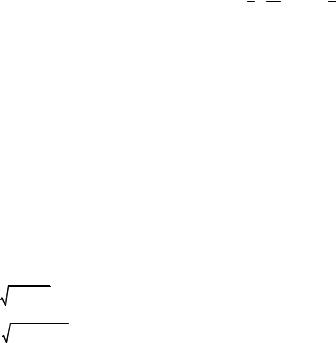
Coordinates of the point A may be received from the parametrical equations for t = 0 ; and t = 1 corresponds to the point B. So, on the segment АВ t [0; 1] .
Taking into account that dx = 2dt, dy = dt, dz = 3dt, we can pass from the line integral to the definite one:
I = 1 (((2t + 2)2 + 2(3t − 1)) 2 + (2t + 2 − t) + (2t + 2 + 2(3t − 1)) 3)dt =
∫
0 |
|
|
|
|
|
|
|
|
|
|
|
|
1 |
2 |
|
8 |
|
3 |
|
53 |
|
2 |
|
|
1 |
|
|
|
|
|||||||||
= ∫ (8t |
|
+ 53t + 6)dt = |
|
t |
|
+ |
|
t |
|
+ 6t |
|
|
|
3 |
|
2 |
|
|
|
||||||
0 |
|
|
|
|
|
|
|
|
|
0 |
= 83 + 532 + 6 = 35 16 .
Micromodule 7
CLASS AND HOME ASSIGNMENTS
Evaluate line integrals of the first type. |
|
|
|
||||||
1. |
∫ sin3 x cos xdl if L is the arc of the curve |
y = ln sin x , |
x [π / 6; π / 2]. |
||||||
|
L |
|
|
|
|
|
|
|
|
2. |
∫ y2 dl |
if L is the cycloid arc x = t − sin t, |
y = 1− cos t |
( 0 ≤ t ≤ 2π). |
|||||
|
L |
|
|
|
|
|
|
|
|
3. |
∫ |
|
dl |
|
if L is the line segment connecting the points А(–2; 0) and В(4;0). |
||||
x |
− y |
||||||||
|
L |
|
|
|
|
||||
|
|
|
|
|
|
|
|
||
4. |
∫ xy−4 dl if L is the arc of the hyperbola |
xy = 1 between two points А(1; 1) |
|||||||
|
L |
|
|
|
|
|
|
|
|
and В(2; 1/2). |
|
|
|
|
|||||
5. |
∫ |
|
x2 + y2 dl if L is the circumference |
x2 + y2 = 2x . |
|
||||
|
L |
|
|
|
|
|
|
|
|
6. |
∫ |
|
x2 + y2 + 1dl if L is the arc of Archimed’s spiral |
ρ = ϕ bounded by |
|||||
|
L |
|
|
|
|
|
|
|
|
two points А(0; 0) and В(1; 1). |
|
|
|
||||||
7. |
∫ xy2 dl |
if L is the circumference arc x = R cos t, y = R sin t ( 0 ≤ t ≤ π / 2 ). |
|||||||
|
L |
|
|
|
|
|
|
|
|
8. |
∫ (x2 + y2 + z2 )dl if L is the arc of the screw line |
x = cos t, y = sin t, |
|||||||
|
L |
|
|
|
|
|
|
|
|
z = bt ( 0 ≤ t ≤ 2π ). |
|
|
|
||||||
9. |
∫ (2x − 3y + z + 4)dl if L is the line segment connecting the points А(1; 3; –1) |
||||||||
|
L |
|
|
|
|
|
|
|
|
and В(2; 0; 3).
170
http://vk.com/studentu_tk, http://studentu.tk/
